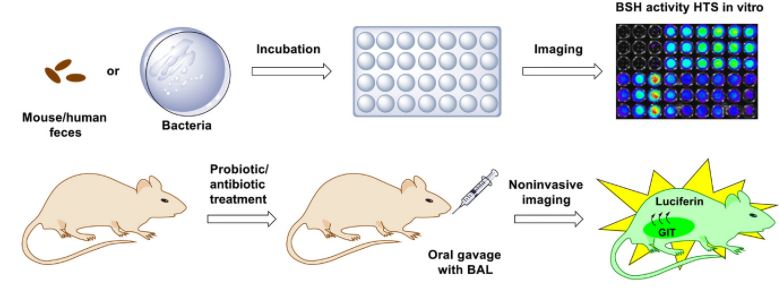Testing prebiotic and probiotic efficacy with bioluminescent capsule in GI tract
08 Feb 2021 --- An international team of scientists has developed a noninvasive diagnostic bioluminescent imaging tool to test the efficacy of prebiotics and probiotics.
The bioluminescent probe arrives in the form of a capsule. When digested, the capsule can help measure bile salt hydrolase (BSH) levels inside the body’s entire gastrointestinal (GI) tract.
BSH is a naturally occurring enzyme responsible for major health-promoting functions of probiotics. Testing BSH can determine the efficacy of many commercially available probiotic supplements.
The tool also evaluates whether certain types of prebiotics can increase BSH levels in a similar way that probiotic supplements do.
“The GI tract has very hard conditions and no assay currently exists to test probiotics for its functional activity,” corresponding study author Elena Goun, associate professor in the Department of Chemistry at the University of Missouri, US, tells NutritionInsight.
“Many people assume that all probiotics on the market work as they are advertised. However, this is not the case. A lot of commercial probiotics we tested didn’t even go into culture in the ‘ideal’ conditions in the test tube,” she flags.
 The BSH-activatable luciferin method is suitable for imaging BSH activity in both mouse and human fecal samples.Goun states this study marks the first example of bioluminescent imaging probes in humans.
The BSH-activatable luciferin method is suitable for imaging BSH activity in both mouse and human fecal samples.Goun states this study marks the first example of bioluminescent imaging probes in humans.
Lighting up the GI tract
The noninvasive method uses bioluminescence, a chemical reaction that produces light inside a living organism, in the form of a capsule.
The researchers synthesized and validated a special set of imaging reagents that produce light proportional to the activity of BSH throughout the GI tract.
“When someone swallows it, it’s exposed to the intact gut microbiota while traveling throughout the harsh environment of a person’s entire gastrointestinal tract,” Goun explains.
“After it passes out of the body, we can analyze a person’s stool sample. We can take the results from that analysis and correlate it with the amount of BSH activity within the human gastrointestinal tract.”
Bioluminescent imaging is non-radioactive and the imaging probes are stable for years. It is the most sensitive imaging modality in living animals, Goun notes, which has been used for imaging of many biological processes.
“However, we are the first ones to adapt this imaging modality for imaging of ‘health promoting’ functional activity of probiotics and prebiotics,” she details.
The lone prebiotic ranger
Prebiotics are often used in combination with probiotics to enhance their functions in the body, but Goun’s research shows certain types of prebiotics alone can increase BSH activity of the gut microbiota.
“In my opinion, this discovery is huge because the production and storage of prebiotics are less expensive than with probiotics.”
Increased BSH activity in the gut via treatment with BSH-positive probiotics or fecal transplants has been shown to confer multiple health benefits to the host. These include:
- Reduced inflammation and blood cholesterol levels.
- Protection against colon cancer and urinary tract infections.
- Significant amelioration of the symptoms of Crohn’s disease, atopic dermatitis and many others.
“We plan to apply this tool to screen the panel of commercially available probiotics and prebiotics. Also, we plan to investigate the role of BSH in various diseases where gut microbiota plays an important role,” Goun envisions.
Noninvasive GI tract technology is creating momentum in the gut health sector. Last week, Lallemand Health Solutions teamed up with medical device company Nimble Science to trial an ingestible capsule that can capture samples of the human gut microbiome.
By Anni Schleicher













